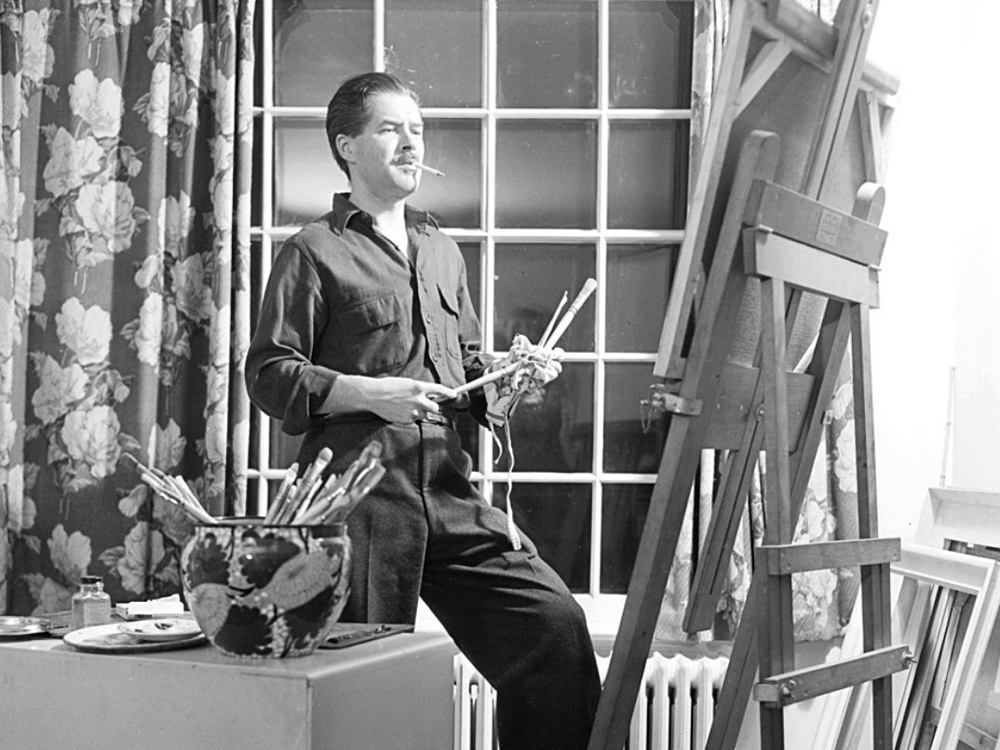At the sprightly age of 52, Jack Bush painted his first Jack Bush—his first stylistically recognizable canvas, replete with his vibrant colours and cleanly, albeit carelessly, lined edges. It was 1960, and Bush had been painting for more than three decades.
Late-blooming artists like Bush are challenging subjects for retrospectives, which by nature aim to look beyond an artist’s highlights to measure their scope and bounds. Accounting for such uneven distribution can be difficult. Why bother with years of mediocrity for one golden decade? But the National Gallery of Canada’s Bush retrospective manages to make even his early works intriguing by interweaving the artist’s stylistic development with his personal relationships, offering a thoroughly humanizing, if slightly diminishing, portrait of the artist.
Three pervasive influences are unearthed from Bush’s extensive diaries and pulled into the gallery. Forming something of a holy trinity, they guide and oversee the exhibition: the therapist, the wife and the critic. Using Bush’s own accounts, wall panels frame paintings with anecdotes. Mabel, his wife, pushed Bush to rework sections of paintings; Allan, his psychiatrist, suggested he experiment with abstraction. To some extent, the emphasis placed on these two influences redresses the narrative held by Bush’s detractors: that he operated at the behest of Clement Greenberg, the aforementioned critic, acting out his principles of flatness and medium specificity in marionette fashion.
The didactics, and Adam Welch’s catalogue essay, place Bush and Greenberg on equal footing. Greenberg gave advice, but it wasn’t always accepted. (Occasionally it was even recanted. After suggesting that Bush crop his paintings, Greenberg realized he had made a mistake, saying, “I can see now—we need all of what you paint, every bit of it. You were right…I was wrong.”) The critic figures as a friend and peer, not an overlord. And navigating his personal relationships was just one pressure, mentioned alongside the artist’s work obligations as a commercial artist, the pressure he felt to provide for his family, and other quotidian details. Rather than presenting Bush as an artist under the influence of one person, co-curators Sarah Stanners and Marc Mayer offer an artist under the influence of many.
While Bush’s personal influences are drawn out from the archives, his artistic ones leap off the walls. As a young artist, Bush bounced from one inspiration to the next. This expanded look at Bush’s work lays his major fault bare: he hews so closely to his citations. He absorbs styles—the gradient clouds of Group of Seven landscapes, the frenzied lines of German Expressionism, and, eventually, the splattered and worked compositions of Abstract Expressionism. Few clues lie buried in these early years; Bush seems more lost than larval.
Some never previously shown works provide new revelations, illustrating that these imitative tendencies continued into his best decade, the 1960s. A series of spill paintings drawing from horticulture—canvases soaked and dipped—immediately bring Helen Frankenthaler to mind. Sure enough, Bush had seen her work some months prior, and these were experiments in her technique. Similarly, his large, horizontal canvases that arrange coloured stripes at diagonals recall Frank Stella.
When Bush moves beyond his heroes, his work gets stronger. It’s a process of distillation, like making gin; he reduces the paintings to their most necessary elements. At this point, the exhibition confirms what everyone already knows: that Bush was an extraordinary colourist. He wields a distinctly mid-century palette—ochres, citrons, olives—but their pairings make magic. Reaching the bright plums and persimmons on the right side of Blue Studio (1968), after travelling across the canvas’s sea of indigo blue, feels something like coming up for air. That said, it’s nothing near a break. Bush makes no attempt at moments of respite. There’s a bite to these tones, an insouciance that marks the best that Colour Field painting has to offer.
If Colour Field painters need one thing, it’s ruthless editing. (Occasionally they took this into their own hands, as Barnett Newman did when he destroyed all of the canvases he made before he turned 40 years old.) But retrospectives forgo such indulgences; they promise an overview, and here is where art criticism and art history divide. I would be more inclined to see an artist as they would like to be seen. Give me ten great works over fifty middling ones any day.
The NGC’s Bush retrospective dilutes his best for a more rounded, generous whole, and, in the process, mounts a necessary response to detractors that would accord his success to Greenberg. It makes sense to abandon the narrative of the artist as a lone genius in Bush’s case. After all, his painting was not prodigious, but painstakingly won.

 Artist Jack Bush painting at an easel (detail). C 3-1-0-0-93, Archives of Ontario.
Artist Jack Bush painting at an easel (detail). C 3-1-0-0-93, Archives of Ontario.







